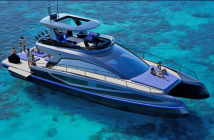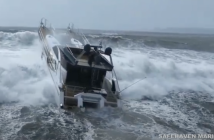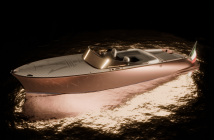Here’s some great, and very timely, advice from BoatUS about where to keep your boat in a hurricane, with specific recommendations if you plan to keep it ashore, on a fixed dock, a floating dock, a canal or river, on a trailer, a lift or a storage rack. Scroll down:
Going back as far as Hurricane Alicia in 1983, our BoatUS Hurricane Catastrophe Team (CAT) professionals have spent thousands of hours working to identify and recover damaged boats. They’ve seen firsthand what works and what doesn’t when a boat is prepared for a hurricane.
When asked where CAT team members would take their own boats if a hurricane warning were posted, most agreed: They’d have it hauled ashore. For many boat owners and marinas, hauling boats is the foundation of their hurricane plan. Some farsighted marinas and yacht clubs have evacuation plans to pull as many boats out of the water as possible whenever a storm is approaching and secure the rest in the largest available slips.
Securing A Boat Ashore
Some types of boats must be pulled if they’re to have any chance of surviving. For instance, smaller open boats and high-performance powerboats with low freeboard will almost always be overcome by waves, spray, and rain. This is true even if the boats have self-bailing cockpits. Fortunately, most of these boats can be placed on trailers and transported inland.
Boats ashore should be stored well above the anticipated storm surge, but even when boats are tipped off jackstands and cradles by rising water, the damage they sustain in a storm tends to be much less severe than the damage to boats left in the water. Windage is also a consideration. If nothing else, reduce windage as much as possible (see Find And Fix Potential Breaking Points). Make sure your boat has extra jackstands, at least three or four on each side for boats under 30 feet, and five or six for larger boats. Jackstands must be supported by plywood and chained together to stop them from spreading. To reduce windage, some ambitious boat owners on the Gulf Coast have dug holes for their sailboat keels so the boats present less windage. Smaller sailboats are sometimes laid on their sides.
One technique that has proven very effective involves strapping boats down to eyes embedded in concrete. At least two marinas in Florida and one in Puerto Rico have used straps with excellent results. One of the Florida marinas strapped the boats to eyes embedded in its concrete storage lot. The other Florida marina and the one in Puerto Rico built heavy concrete runners (similar to long, narrow concrete deadweight moorings) beneath the boats to anchor the straps. (Straps made from polyester work better than nylon, which has more stretch). Even when the wind has been on the beam and water has come into the storage area, the straps held and boats stayed upright. An alternative tried at other marinas has been to use earth augers screwed into the ground to secure the straps. Results with the latter technique have been mixed; some have held while others have been pulled out. All things considered, any attempt to anchor a boat on shore is worth the effort. Read more: https://www.boatus.com/expert-advice/expert-advice-archive/2019/august/where-to-keep-your-boat-during-a-hurrican




